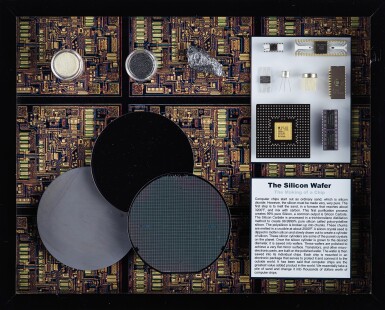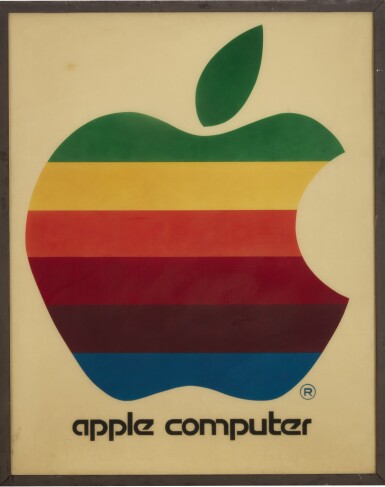From the Computing History Collection of Serge Roube, via his Estate[HARVARD COMPUTING HISTORY]Album of Vintage Photographs of the Harvard Cruft Laboratory and Construction of the Harvard Mark I, circa 1944-1965 Two 11¼ x 15¼ inch black photo albums, containing 164 silver gelatin prints of various sizes (ranging from approximately 4¾ x 6¾ to 7¼ x 10 in.), mounted onto black paper, and 9 loose photographs, of which 3 bear the Harvard University stamp to versos. [WITH] Xerox copy of Howard Hathaway Aiken's "Curriculm [sic] Vitae," 7 pp. Albums rubbed, some chipping to paper, but photos overall in beautiful condition, with occasional toning. A PIVOTAL MOMENT IN THE HISTORY OF COMPUTING — THE CONSTRUCTION OF THE MARK I, AND THE REALIZATION OF THE PRINCIPLES OF BABBAGE'S ANALYTICAL ENGINE This archive of photographs depicts Harvard's Cruft Laboratory, and the construction of the famed IBM Automatic Sequence Controlled Calculator (the Harvard Mark I), shown in various states of assembly from empty concrete room, to blown out doorways and delivery of components, to installation, testing, and opening ceremonies. The Mark I was the product of physicist and computing pioneer Howard Aiken — pictured numerous times throughout the archive — who first conceived of building a powerful, large-scale calculating machine in 1935. In 1937, while a professor of applied mathematics at Harvard's Graduate School of Engineering, Aiken proposed his idea to a number of manufacturers, and received several rejections before finally convincing IBM to undertake the project. In his association with IBM, Aiken worked alongside engineers Frank E. Hamilton, Clair D. Lake, and Benjamin M. Durfee, also pictured in the present lot. The project was partly funded by the United States Navy, and the remainder came from IBM. The assembly of the Mark I was a massive undertaking. It weighed five tons, contained 765,000 electromechanical components, used 500 miles of wire and 3,000,000 wire connections, 3,500 multiple relays with 35,000 contacts, 2,225 counters, and 1,484 ten-pole switches. After the Mark I was installed at Harvard in February, 1944, it was commandeered for war work by the United States Navy, and Aiken—a commander in the United States Naval Reserve—was put in charge of the navy's computation project. The machine was in use throughout the war years and beyond, until it was disassembled in 1959. During that time, it also served generations of students in Aiken's pioneering computer science program at Harvard, many of whom would go on to produce significant work in the field of computing.
From the Computing History Collection of Serge Roube, via his Estate[HARVARD COMPUTING HISTORY]Album of Vintage Photographs of the Harvard Cruft Laboratory and Construction of the Harvard Mark I, circa 1944-1965 Two 11¼ x 15¼ inch black photo albums, containing 164 silver gelatin prints of various sizes (ranging from approximately 4¾ x 6¾ to 7¼ x 10 in.), mounted onto black paper, and 9 loose photographs, of which 3 bear the Harvard University stamp to versos. [WITH] Xerox copy of Howard Hathaway Aiken's "Curriculm [sic] Vitae," 7 pp. Albums rubbed, some chipping to paper, but photos overall in beautiful condition, with occasional toning. A PIVOTAL MOMENT IN THE HISTORY OF COMPUTING — THE CONSTRUCTION OF THE MARK I, AND THE REALIZATION OF THE PRINCIPLES OF BABBAGE'S ANALYTICAL ENGINE This archive of photographs depicts Harvard's Cruft Laboratory, and the construction of the famed IBM Automatic Sequence Controlled Calculator (the Harvard Mark I), shown in various states of assembly from empty concrete room, to blown out doorways and delivery of components, to installation, testing, and opening ceremonies. The Mark I was the product of physicist and computing pioneer Howard Aiken — pictured numerous times throughout the archive — who first conceived of building a powerful, large-scale calculating machine in 1935. In 1937, while a professor of applied mathematics at Harvard's Graduate School of Engineering, Aiken proposed his idea to a number of manufacturers, and received several rejections before finally convincing IBM to undertake the project. In his association with IBM, Aiken worked alongside engineers Frank E. Hamilton, Clair D. Lake, and Benjamin M. Durfee, also pictured in the present lot. The project was partly funded by the United States Navy, and the remainder came from IBM. The assembly of the Mark I was a massive undertaking. It weighed five tons, contained 765,000 electromechanical components, used 500 miles of wire and 3,000,000 wire connections, 3,500 multiple relays with 35,000 contacts, 2,225 counters, and 1,484 ten-pole switches. After the Mark I was installed at Harvard in February, 1944, it was commandeered for war work by the United States Navy, and Aiken—a commander in the United States Naval Reserve—was put in charge of the navy's computation project. The machine was in use throughout the war years and beyond, until it was disassembled in 1959. During that time, it also served generations of students in Aiken's pioneering computer science program at Harvard, many of whom would go on to produce significant work in the field of computing.















Try LotSearch and its premium features for 7 days - without any costs!
Be notified automatically about new items in upcoming auctions.
Create an alert